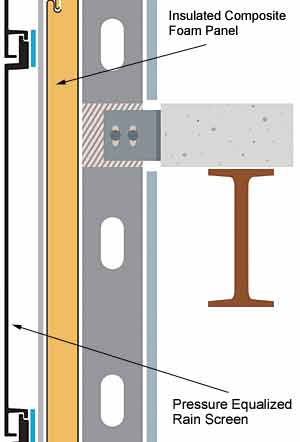Thermal and Moisture Control in Exterior Metal Walls
8. Details on the Importance of Superior
Air Barrier and Vapor Barrier Continuity
The following are important when designing and specifying exterior metal walls with superior thermal and moisture control:
Vapor drive and vapor barrier location
according to climate.
Vapor diffusion causes moisture to penetrate wall materials.
In certain climates, vapor barriers (perm ratings less than
1.0) are used to prevent vapor diffusion. Vapor pressure is
greatest at high temperatures and high relative humidity.
The greater the
vapor pressure difference from inside to outside, the greater
the vapor diffusion concern. In climates like the hot and
humid southeast U.S., the logical location for a vapor barrier
is outside the insulation and in cold climates, a vapor barrier
is required on the inside of the insulation. In moderate climates,
where the vapor drive is bi-directional−outside to inside
during summer, inside to outside during winter− a standard
vapor barrier is not recommended. Instead, a special vapor
barrier that varies its perm rating−low during the dry
winter, high during the humid summer−is recommended on
the interior of the wall assembly.
Multi-component wall systems combine
barriers.
Creating vapor barrier and retarder continuity is very difficult
to achieve on the interior of stud framing due to electrical
penetrations and discontinuities at the floor and ceiling.
To improve vapor barrier and retarder continuity, the Massachusetts
Building Code's suggested details combine the function
of the vapor barrier and retarder with the air and water barrier
in a rubberized asphaltic barrier located outboard of the
studs between rigid insulation and exterior gypsum sheathing.
In the hot and humid climates the same rubberized asphaltic
layer is placed over exterior gypsum sheathing located outboard
of the studs, with the insulation located within the stud
cavity.
Air and water barrier continuity
is the key.
The volume of moisture transported by airflow is 50 to 200
times greater than the volume of moisture transported by vapor
diffusion. Air from any small leak can travel throughout the
inside of a wall, dropping condensation, whenever the temperature
falls below the dew point. This moisture usually becomes trapped
and can lead to wall system degradation. Therefore it's
imperative that the air and vapor barriers be continuous.
Relocating the air and vapor barriers outboard of the stud
line is a big step toward achieving this continuity.
Superior wall performance should
always be sought.
Avoid the many hazards of thin wraps and rubberized membranes
by specifying and designing wall systems that provide superior
air, water, and vapor control performance. Further, use systems
that provide superior thermal performance with continuous
insulation that is not compromised by metal studs, penetrations,
or difficult details.
9. Wall Systems with Superior Performance
There are several different types of wall systems that are worth special attention.
Superior Wall System 1:
Outboard insulated panel and pressure
equalized rainscreen
System 1 is a multi-component system with only two elements:
a pressure equalized exterior rainscreen and an insulated
composite foam panel backup (Figure 18). The exterior element
provides ventilation to the cavity, while limiting water infiltration.
It is tested at 15 psf and an imperfect air barrier. The insulated
composite foam panel provides:
- Integral vapor retarder
- Integral air barrier
- Integral water barrier
- ASHRAE rated insulation R values as high as 26.5. Key benefits of the System 1 insulated wall include:
- One company is responsible for the wall.
- Composite foam panels have 35 years or more of performance as an exterior wall panel.
- Functioning behind an excellent rainscreen will provide lengthy service.
- Studs are on the warm side of the insulation and less subject to corrosion.
- Continuity of vapor barriers.
- Functions in all climatic conditions.
|










